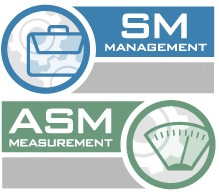SM/ASM 2000 - Software Management & Applications of Software Measurement

PRESENTATIONS
|
Interpreting Graphical Defect Trend Data
Evaluation of graphical defect trend data can dramatically increase your ability to predict current project quality, schedule milestone compliance, and provide historical data for proper test and development scheduling of later revisions. Jim Olsen will explore some of the complexities in analyzing graphic defect trending in this presentation (winner of the Best Presentation award for ASM'99). |
|
|
Introducing Personal Software Process--A Few (Un)Expected Lessons
Learn how one company successfully implemented SEI-PSP to a significant part of its software engineering organization. Key discussion points include organization readiness, a training approach, lessons learned, and ways to successfully introduce PSP into an organization. Discover the three process areas (inspections, planning, and quality) where PSP can have a significant impact. |
|
|
Leveraging Software Resources
The Critical Chain approach to project management is being applied on more and more software development projects to achieve significant benefits in quality of life, lead time, and productivity. Rob Newbold provides an overview of the Critical Chain approach as it applies to software development. Where is time and energy typically wasted? How can we focus attention on those areas where improvement will do the most good? |
|
|
Management of Outsourcing--How to Avoid Common Mistakes
One of the most challenging areas of software management is encountered in the first year after an outsourcing contract is signed. Carol Dekkers discusses the actions that can be taken by both implementation teams to ease the transition and to achieve outsourcing success. Learn of the common mistakes made involving personnel, measurement, and expectations, and obtain recommendations to increase the transition to a successful partnership. |
|
|
Managing Business Dynamics for Software Developers
Managing a software development project is a complex mix of many forces--market expectations, the development process, product legacy, people skills, timelines, and budget. While several of these factors may be independent or even uncontrollable, they need to be factored together for success. This is the ultimate challenge of a development manager. Using several scenarios of market and production evolution, Ram Chillarege illustrates these business dynamics. |
|
|
Managing Software Project Schedules with Efficiency
Software on-time delivery statistics show schedule slippage is a common phenomenon within the software industry. Ziya Ma discusses the results of an industry survey conducted during 1998 and 1999 to obtain current, valid, and useful scheduling data. Learn how to use this information--including common approaches to on-time delivery used in modern industry--to tackle project delays in a timely manner. |
|
|
Measurement Maturity at CMM Level 3
The SEI's Capability Maturity Model for Software (SW-CMM) considers measurement a key element in the effective management of software development. Two lead assessors provide insight into the measurement requirements embedded throughout the model's key practices at Levels 2 and 3. Examples of mature Level 3 measurement systems and recommendations based on lessons learned will be provided. |
|
|
Measuring and Benchmarking IT Performance
IT leaders strive to continuously improve their software development and support practices by keeping watch on the industry's best practices. To assist with this task, they turn to the International Software Benchmarking Standards Group (ISBSG) industry performance profile data. Learn how to use this data in establishing performance goals and improving current software development practices. |
|
|
Measuring the Complexity and Impact of Design Changes
Mike Libassi discusses how to use the Weighted Stability Index (WSI) Metrics Model, an adaptation of a U.S. Army method, to measure system design changes and the impact to software releases. Both the original method and the WSI model will be presented, as well as customization, results interpretation, and implementation. Learn how to automate this model into current office technology, like Microsoft Excel and Access. |
|
|
Mindless Process Improvement--Just Say NO!
The most common approach for process improvement is to document all processes. This process-centric approach can work, but it has a high risk of failure. Neil Potter and Mary Sakry discuss an approach to scoping an improvement program based on problems and goals of the organization. Learn how to use this approach to make sifnificant progress on real issues and on the process improvement model or standard you are trying to achieve. |
|
Pages
Recommended Web Seminars
| On Demand | Building Confidence in Your Automation |
| On Demand | Leveraging Open Source Tools for DevSecOps |
| On Demand | Five Reasons Why Agile Isn't Working |
| On Demand | Building a Stellar Team |
| On Demand | Agile Transformation Best Practices |


